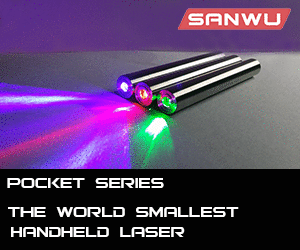Trevor
0
- Joined
- Jul 17, 2009
- Messages
- 4,386
- Points
- 113
Although I'm a freshman (Virginia Tech), I'm beginning to work on my thesis as of this spring. It's part of the University Honors program here (not a specific college), therefore the thesis process is more laid-back than most.
I've settled on working with line-of-sight data transfer using laser, as this is a good marriage of my major (Business Information Technology), my interest in circuitry, my interest in laser, and my background in programming.
Before I can apply for grant money, I'd like to provide a smaller-scale proof-of-concept. I've worked with my EE friends to draw up bare-bones circuit diagrams that perform the system's most basic needs, and I've begun writing the firmware in what spare time I can scrape together.
The last main decision that needs to be made is wavelength. I've narrowed my options to 405nm, 532nm, 650nm, and 808nm. I've drawn up my list of perceived pros and cons, and I'm interested to see what you guys think.
This list was compiled from tidbits I've read around the forum. If I've misinterpreted anything, please call me out on it so I can rearrange my list and correct things. I'm eager to learn and want to make the most educated and thought-out decision possible.
Thanks,
Trevor
I've settled on working with line-of-sight data transfer using laser, as this is a good marriage of my major (Business Information Technology), my interest in circuitry, my interest in laser, and my background in programming.
Before I can apply for grant money, I'd like to provide a smaller-scale proof-of-concept. I've worked with my EE friends to draw up bare-bones circuit diagrams that perform the system's most basic needs, and I've begun writing the firmware in what spare time I can scrape together.
The last main decision that needs to be made is wavelength. I've narrowed my options to 405nm, 532nm, 650nm, and 808nm. I've drawn up my list of perceived pros and cons, and I'm interested to see what you guys think.
- 405nm
- Pros
- Easier collimation - lower divergence?
- Medium affordability at medium to high power.
- Cons
- High susceptibility to Rayleigh Scattering - less light making it to the sensor?
- Lab systems not easily obtainable?
- Pros
- 532nm
- Pros
- Medium collimation ability due to wavelength.
- Less susceptible to divergence due to wavelength.
- Lab units easier to come by.
- Cons
- Must be DPSS - diodes are prohibitively expensive.
- Higher power requirement due to pump diode.
- Higher heat output due to powerful pump diode.
- Pros
- 650nm
- Pros
- Fairly low cost to power ratio.
- Widely available.
- Lower susceptibility to Rayleigh scattering.
- Cons
- More susceptible to divergence due to wavelength.
- Pros
- 808nm
- Pros
- Very low cost to power ratio.
- Widely available.
- Lab units easy to come by.
- Cons
- Invisible, hard to aim!
- More dangerous due to visibility.
- Pros
This list was compiled from tidbits I've read around the forum. If I've misinterpreted anything, please call me out on it so I can rearrange my list and correct things. I'm eager to learn and want to make the most educated and thought-out decision possible.
Thanks,
Trevor



